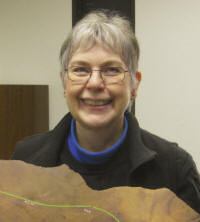Katie Hirschboeck
Associate Professor Emerita of Climatology

- Bannister 319
A unifying theme in Dr. Katie Hirschboeck’s research is the linkage between atmospheric circulation, along with its associated weather and climate mechanisms, and variability in extreme events. Her investigations have progressed from the theoretical examination of the patterns that produce extreme flood events in statistical time series, to analyses of the synoptic circulation patterns that produce frost rings and drought signals in tree-ring records, to new stakeholder-driven research on synchronous high and low extreme streamflow episodes detected from tree-ring reconstructions (in collaboration with Dave Meko) Hirschboeck’s tree-ring related research is based on synoptic dendroclimatology, an approach that links tree ring variations to weather events and atmospheric circulation patterns. Research questions that she has been addressing over the past decade include:
- What role does large-scale atmospheric circulation and its attendant weather events play in local and regional tree-growth responses as revealed in tree-ring records? and
- How can a mechanistic link between circulation and tree rings be used to improve the understanding of past climatic variability from a process-based perspective? She uses a variety of techniques, such as manual and automated synoptic circulation typing, the integration of atmospheric sounding data into traditional dendroclimatic analyses, and various statistical approaches, to advance a more process-based understanding and interpretation of tree-ring reconstructions of both climatic and hydrologic variables.
Hirschboeck’s flood-climate research centers on flood hydroclimatology, the analysis of observed floods and paleofloods in the context of their history of variation over time and the meteorological processes that produce them. Research questions being addressed include: - How can an understanding of the atmospheric and hydrologic mechanisms that produce floods and droughts in the observed and paleo- records be used to assess the nonstationarity of hydrologic time series and the reliability of flood estimates and drought probabilities?
- How are anomalous atmospheric circulation patterns and persistence linked to clustering of major flood or low flow events in time and space? and
- Can knowledge of circulation patterns and hydrologic processes examined over long climatological time scales improve meteorological flood forecasting?

